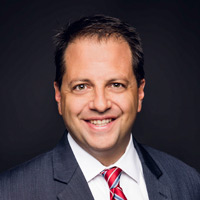Transitioning to Retirement Is Like Moving to a New World – Bring a Map
To truly be ready to retire, you need to fully explore the unfamiliar territory ahead. Your retirement future can be broken down into five distinct "worlds," each with its own danger zones that you need to navigate.


Maybe you managed to pull together a down payment for your first house without some sort of formal savings plan. Many people do.
Maybe you even got your kids through college without any real strategy for how to pay for it. It happens.
So maybe you think you can lick this retirement savings thing, too. Perhaps with a buy-and-hold investment strategy, or simply figuring it out as you go, you’ll hoist yourself over one last financial hurdle before you hit the finish line. Good luck.
From just $107.88 $24.99 for Kiplinger Personal Finance
Become a smarter, better informed investor. Subscribe from just $107.88 $24.99, plus get up to 4 Special Issues

Sign up for Kiplinger’s Free Newsletters
Profit and prosper with the best of expert advice on investing, taxes, retirement, personal finance and more - straight to your e-mail.
Profit and prosper with the best of expert advice - straight to your e-mail.
Retirement isn’t the finish line; it’s the starting line for a whole new way of life. One without a paycheck.
You’ll be living off relatively fixed finances, on an income you determine yourself. So, the decisions you make as you transition from working to retirement will help establish how long your money will last and how comfortable you’ll be. To make the journey to and through retirement without some sort of plan just might be the most daunting endeavor you could ever take on.
Yet, people try it. Some without even realizing how unprepared they are. Like a married couple I met with recently in my office: Mid- to late-50s. All assets focused on growth. No income plan, really, just a hodgepodge of investments that meant they’d do well when the market is up and have to live leanly when it’s down.
They had a portfolio. They needed a plan.
Over the years, we’ve seen investors in this same situation over and over again. Some are worried, some unaware, some simply naïve about what they’ll need for the retirement lifestyle they want. All are vulnerable — even if they’ve worked hard at saving — because they’re traveling new territory without a map.
So we talk about the obstacles they might encounter that could keep them from experiencing the retirement they want. There are the obstacles they know about — and those are typically the concerns they come in with — but there are also barriers they don’t foresee that could keep them from enjoying their wealth to the fullest.
Wealth has two sides: lifestyle and legacy. If you could wave a magic wand and have anything you wanted, what would that look like? Think of it like pulling up Google Maps: You put in the destination first and then find your way.
We call our process the “Retirement Navigator,” and it takes each client through five “worlds” they should explore before and during their retirement.
World No. 1 – Income
Maybe you’ll have a pension, and, of course, there’s your Social Security benefit. But you’ll likely need to use your nest egg to make sure an adequate retirement paycheck keeps coming month after month. The first step for most is to change focus from accumulation to preservation. When you retire, the rules change. You can’t just ride the market up and down the way you did when you were younger and had time to recover from a loss. You’ll want to include strategies that provide consistent income, so you can have the lifestyle you want no matter what happens in the market. These strategies might include income-producing real estate, guaranteed annuities, CDs and/or bonds.
World No. 2 – Growth
The challenge here is to put together a portfolio that’s less vulnerable to volatility but still includes investments that will help offset inflation. This could include a more focused approach — an institutional portfolio or actively managed account — to help minimize risk and take advantage of growth opportunities. You also might want to consider alternative investments such as commodities or real estate.
World No. 3 – Tax-efficiency
Of course, your income and investment plans won’t be worth much if you end up giving most of your money back to Uncle Sam. So you’ll want to make sure all the pieces of your plan are working in the most tax-efficient way. It seems as if many Americans’ CPAs are on one side of town and their financial advisers are on the other; they might talk once a year or not at all. Why not bring the two together when building and modifying your overall plan? That way you can be sure you’re not only making the best moves year to year but also through your entire retirement and even to the benefit of your beneficiaries. Consider tax-favored investments or insurance products that can minimize your tax bill in retirement.
World No. 4 – Health and Long-Term Care
According to one report from the U.S. Senate, the cost of seniors’ most commonly used brand-name drugs is increasing at 10 times the rate of inflation. The U.S. Centers for Medicare and Medicaid Services projects health care spending will rise 5.5% annually, on average, from now until 2026. Long-term care costs are just as daunting; Genworth’s “2018 Cost of Care Survey” reported annual median costs of long-term care support services increased an average of 3% from 2017 to 2018, with some categories surpassing by two to three times the 2.1% U.S. inflation rate . The insurance industry is creating more products aimed at long-term care, including life insurance that allows you to access the death benefit under certain circumstances. The important thing here is to explore all your options before you need care.
World No. 5 – Leaving a Legacy
This is another often-ignored piece of retirement planning. A 2017 Ameriprise study found that most survey participants (83%) want to leave money or assets to a loved one; however, only 64% feel they’re on track to leave an inheritance, and even fewer (50%) have a formal plan in place. It’s possible to design a plan that helps accomplish your income goals first, while allowing room to leave a legacy. This is also an area where there can be a disconnect among advisers, so make sure your financial adviser, CPA and attorney are on the same page regarding your wishes.
Having a navigation process can help you maneuver past the obstacles on the way to retirement and allow you to enjoy yourself more once you get there. You won’t have to monitor the stock market or worry about which world events might affect your nest egg. Instead, you can put your energy into crossing off the items on your bucket list.
Fee-based financial planning and investment advisory services are offered by Ladin Financial Group, a Registered Investment Advisor in the State of Florida. Insurance products and services are offered through Ladin Consulting Group. Ladin Financial Group and Ladin Consulting Group are affiliated companies. Investing involves risk, including the potential loss of principal. Any references to guarantees generally refer to fixed insurance products, never securities or investment products. Insurance and annuity product guarantees are backed by the financial strength and claims-paying ability of the issuing insurance company. Our firm does not provide, nor is any statement contained here in intended to provide tax or legal advice, all individuals are encouraged to consult with qualified professionals prior to making any decisions about their personal situation.
Kim Franke-Folstad contributed to this article.
Profit and prosper with the best of Kiplinger's advice on investing, taxes, retirement, personal finance and much more. Delivered daily. Enter your email in the box and click Sign Me Up.

Michael Ladin is founder and CEO of Ladin Tax & Financial Group, a firm that focuses on assisting Florida business owners, Baby Boomers and retirees with retirement income strategies that work in a tax-efficient way.
-
 CD Maturing Soon? Here's What to Do Next
CD Maturing Soon? Here's What to Do NextThese strategies of what to do when you have a CD maturing soon will have you maximizing returns even with rate cuts.
-
 How to Make 2026 Your Best Year Yet for Retirement Savings
How to Make 2026 Your Best Year Yet for Retirement SavingsMake 2026 the year you stop coasting and start supercharging your retirement savings.
-
 You Saved for Retirement: 4 Pressing FAQs Now
You Saved for Retirement: 4 Pressing FAQs NowSaving for retirement is just one step. Now, you have to figure out how to spend and maintain funds. Here are four frequently asked questions at this stage.
-
 I'm a Financial Planning Pro: This Is How You Can Stop These 5 Risks From Wrecking Your Retirement
I'm a Financial Planning Pro: This Is How You Can Stop These 5 Risks From Wrecking Your RetirementYour retirement could be jeopardized if you ignore the risks you'll face later in life. From inflation to market volatility, here's what to prepare for.
-
 Are You Hesitating to Spend Money You've Spent Years Saving? Here's How to Get Over It, From a Financial Adviser
Are You Hesitating to Spend Money You've Spent Years Saving? Here's How to Get Over It, From a Financial AdviserEven when your financial plan says you're ready for a big move, it's normal to hesitate — but haven't you earned the right to trust your plan (and yourself)?
-
 Time to Close the Books on 2025: Don't Start the New Year Without First Making These Money Moves
Time to Close the Books on 2025: Don't Start the New Year Without First Making These Money MovesAs 2025 draws to a close, take time to review your finances, maximize tax efficiency and align your goals for 2026 with the changing financial landscape.
-
 Is Fear Blocking Your Desire to Retire Abroad? What to Know to Turn Fear Into Freedom
Is Fear Blocking Your Desire to Retire Abroad? What to Know to Turn Fear Into FreedomCareful planning encompassing location, income, health care and visa paperwork can make it all manageable. A financial planner lays it all out.
-
 How to Master the Retirement Income Trinity: Cash Flow, Longevity Risk and Tax Efficiency
How to Master the Retirement Income Trinity: Cash Flow, Longevity Risk and Tax EfficiencyRetirement income planning is essential for your peace of mind — it can help you maintain your lifestyle and ease your worries that you'll run out of money.
-
 I'm an Insurance Expert: Sure, There's Always Tomorrow to Report Your Claim, But Procrastination Could Cost You
I'm an Insurance Expert: Sure, There's Always Tomorrow to Report Your Claim, But Procrastination Could Cost YouThe longer you wait to file an insurance claim, the bigger the problem could get — and the more leverage you're giving your insurer to deny it.
-
 Could a Cash Balance Plan Be Your Key to a Wealthy Retirement?
Could a Cash Balance Plan Be Your Key to a Wealthy Retirement?Cash balance plans have plenty of benefits for small-business owners. For starters, they can supercharge retirement savings and slash taxes. Should you opt in?
-
 7 Retirement Planning Trends in 2025: What They Mean for Your Wealth in 2026
7 Retirement Planning Trends in 2025: What They Mean for Your Wealth in 2026From government shutdowns to market swings, the past 12 months have been nothing if not eventful. The key trends can help you improve your own financial plan.